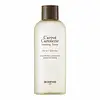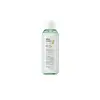What's inside
What's inside
 Key Ingredients
Key Ingredients

 Benefits
Benefits

 Concerns
Concerns

 Ingredients Side-by-side
Ingredients Side-by-side

Water
Skin ConditioningDaucus Carota Sativa Root Extract 18%
Skin ConditioningGlycerin
HumectantButylene Glycol
Humectant1,2-Hexanediol
Skin ConditioningPPG-13-Decyltetradeceth-24
EmulsifyingEthylhexylglycerin
Skin ConditioningSodium Citrate
BufferingUndaria Pinnatifida Extract
Skin ConditioningCamellia Sinensis Leaf Extract
AntimicrobialCentella Asiatica Extract
CleansingBrassica Oleracea Italica Extract
AstringentSodium Hyaluronate
HumectantCitric Acid
BufferingSodium Phytate
Brassica Oleracea Capitata Leaf Extract
Skin ConditioningMomordica Charantia Fruit Extract
Skin ConditioningBeta-Glucan
Skin ConditioningAllantoin
Skin ConditioningHydroxyethylcellulose
Emulsion StabilisingMaltodextrin
AbsorbentSaccharide Hydrolysate
HumectantDaucus Carota Sativa Seed Oil
EmollientOlea Europaea Fruit Oil
MaskingPogostemon Cablin Leaf Oil
MaskingLavandula Hybrida Oil
EmollientSalvia Officinalis Oil
MaskingArtemisia Vulgaris Oil
PerfumingCitrus Aurantium Dulcis Peel Oil
MaskingCaprylyl Glycol
EmollientWater, Daucus Carota Sativa Root Extract 18%, Glycerin, Butylene Glycol, 1,2-Hexanediol, PPG-13-Decyltetradeceth-24, Ethylhexylglycerin, Sodium Citrate, Undaria Pinnatifida Extract, Camellia Sinensis Leaf Extract, Centella Asiatica Extract, Brassica Oleracea Italica Extract, Sodium Hyaluronate, Citric Acid, Sodium Phytate, Brassica Oleracea Capitata Leaf Extract, Momordica Charantia Fruit Extract, Beta-Glucan, Allantoin, Hydroxyethylcellulose, Maltodextrin, Saccharide Hydrolysate, Daucus Carota Sativa Seed Oil, Olea Europaea Fruit Oil, Pogostemon Cablin Leaf Oil, Lavandula Hybrida Oil, Salvia Officinalis Oil, Artemisia Vulgaris Oil, Citrus Aurantium Dulcis Peel Oil, Caprylyl Glycol
Water
Skin ConditioningButylene Glycol
HumectantVitis Vinifera Fruit Extract
Skin ConditioningAlcohol
AntimicrobialSalicylic Acid
MaskingTromethamine
BufferingSodium Citrate
BufferingPPG-13-Decyltetradeceth-24
Emulsifying1,2-Hexanediol
Skin ConditioningPolyglyceryl-10 Laurate
Skin ConditioningHydroxyacetophenone
AntioxidantGluconolactone
Skin ConditioningBetaine
HumectantSalix Alba Bark Extract
AstringentPanthenol
Skin ConditioningParfum
MaskingAllantoin
Skin ConditioningCitric Acid
BufferingSodium Phytate
Prunus Mume Fruit Extract
HumectantLactuca Scariola Sativa Leaf Extract
Skin ConditioningCucumis Sativus Fruit Extract
EmollientEnantia Chlorantha Bark Extract
Skin ConditioningArgania Spinosa Kernel Oil
EmollientBeta-Glucan
Skin ConditioningSodium Hyaluronate
HumectantCaprylyl Glycol
EmollientSesamum Indicum Seed Oil
EmollientHydroxypropyltrimonium Hyaluronate
Beta-Sitosterol
Emulsion StabilisingSerenoa Serrulata Fruit Extract
Skin ConditioningOleanolic Acid
Skin ConditioningSodium Acetylated Hyaluronate
HumectantHydrolyzed Hyaluronic Acid
HumectantTocopherol
AntioxidantHyaluronic Acid
HumectantSodium Hyaluronate Crosspolymer
HumectantHydrolyzed Sodium Hyaluronate
Skin ConditioningPotassium Hyaluronate
Skin ConditioningWater, Butylene Glycol, Vitis Vinifera Fruit Extract, Alcohol, Salicylic Acid, Tromethamine, Sodium Citrate, PPG-13-Decyltetradeceth-24, 1,2-Hexanediol, Polyglyceryl-10 Laurate, Hydroxyacetophenone, Gluconolactone, Betaine, Salix Alba Bark Extract, Panthenol, Parfum, Allantoin, Citric Acid, Sodium Phytate, Prunus Mume Fruit Extract, Lactuca Scariola Sativa Leaf Extract, Cucumis Sativus Fruit Extract, Enantia Chlorantha Bark Extract, Argania Spinosa Kernel Oil, Beta-Glucan, Sodium Hyaluronate, Caprylyl Glycol, Sesamum Indicum Seed Oil, Hydroxypropyltrimonium Hyaluronate, Beta-Sitosterol, Serenoa Serrulata Fruit Extract, Oleanolic Acid, Sodium Acetylated Hyaluronate, Hydrolyzed Hyaluronic Acid, Tocopherol, Hyaluronic Acid, Sodium Hyaluronate Crosspolymer, Hydrolyzed Sodium Hyaluronate, Potassium Hyaluronate
Ingredients Explained
These ingredients are found in both products.
Ingredients higher up in an ingredient list are typically present in a larger amount.
1,2-Hexanediol is a synthetic liquid and another multi-functional powerhouse.
It is a:
- Humectant, drawing moisture into the skin
- Emollient, helping to soften skin
- Solvent, dispersing and stabilizing formulas
- Preservative booster, enhancing the antimicrobial activity of other preservatives
Allantoin is a soothing ingredient known for its protective and moisturizingg properties. Because of this, it is often added to products with strong active ingredients.
Studies show higher concentrations of this ingredient can promote wound healing.
Though it can be derived from the comfrey plant, allantoin is produced synthetically for cosmetic products to ensure purity.
Learn more about AllantoinBeta-Glucan is a polysaccharide. It can be derived from the cell walls of seaweed, oats, yeast, and fungi. It hydrates the skin and helps boost your skin's natural barrier.
As an antioxidant, beta-glucan helps fight free-radicals. Free-radicals are molecules that may damage your skin cells, such as pollution.
Studies show this ingredient may be an effective wrinkle reducer as it can deeply penetrate into skin. It has also been show to help with wound healing.
Learn more about Beta-GlucanButylene Glycol (or BG) is used within cosmetic products for a few different reasons:
Overall, Butylene Glycol is a safe and well-rounded ingredient that works well with other ingredients.
Though this ingredient works well with most skin types, some people with sensitive skin may experience a reaction such as allergic rashes, closed comedones, or itchiness.
Learn more about Butylene GlycolCaprylyl Glycol is a humectant and emollient, meaning it attracts and preserves moisture.
It is a common ingredient in many products, especially those designed to hydrate skin. The primary benefits are retaining moisture, skin softening, and promoting a healthy skin barrier.
Though Caprylyl Glycol is an alcohol derived from fatty acids, it is not the kind that can dry out skin.
This ingredient is also used as a preservative to extend the life of products. It has slight antimicrobial properties.
Learn more about Caprylyl GlycolCitric Acid is an alpha hydroxy acid (AHA) naturally found in citrus fruits like oranges, lemons, and limes.
Like other AHAs, citric acid can exfoliate skin by breaking down the bonds that hold dead skin cells together. This helps reveal smoother and brighter skin underneath.
However, this exfoliating effect only happens at high concentrations (20%) which can be hard to find in cosmetic products.
Due to this, citric acid is usually included in small amounts as a pH adjuster. This helps keep products slightly more acidic and compatible with skin's natural pH.
In skincare formulas, citric acid can:
While it can provide some skin benefits, research shows lactic acid and glycolic acid are generally more effective and less irritating exfoliants.
Most citric acid used in skincare today is made by fermenting sugars (usually from molasses). This synthetic version is identical to the natural citrus form but easier to stabilize and use in formulations.
Read more about some other popular AHA's here:
Learn more about Citric AcidWe don't have a description for PPG-13-Decyltetradeceth-24 yet.
Sodium Citrate is the sodium salts of citric acid. In skincare, it is used to alter pH levels and acts as a preservative.
Its main functions are to maintain the pH of a product and neutralize metal ions.
The acidity of our skin is maintained by our glands and skin biome; normal pH level of skin is slightly acidic (~4.75-5.5).
Being slightly acidic allows our skin to create an "acid mantle". This acid mantle is a thin barrier that protects our skin from bacteria and contaminants.
Learn more about Sodium CitrateSodium Hyaluronate is hyaluronic acid's salt form. It is commonly derived from the sodium salt of hyaluronic acid.
Like hyaluronic acid, it is great at holding water and acts as a humectant. This makes it a great skin hydrating ingredient.
Sodium Hyaluronate is naturally occurring in our bodies and is mostly found in eye fluid and joints.
These are some other common types of Hyaluronic Acid:
Learn more about Sodium HyaluronateSodium Phytate is the synthetic salt form of phytic acid. Phytic acid is an antioxidant and can be found in plant seeds.
Sodium Phytate is a chelating agent. Chelating agents help prevent metals from binding to water. This helps stabilize the ingredients and the product.
Water. It's the most common cosmetic ingredient of all. You'll usually see it at the top of ingredient lists, meaning that it makes up the largest part of the product.
So why is it so popular? Water most often acts as a solvent - this means that it helps dissolve other ingredients into the formulation.
You'll also recognize water as that liquid we all need to stay alive. If you see this, drink a glass of water. Stay hydrated!
Learn more about Water